Past Events
Interested in Cotsen events? Sign up for our mailing list.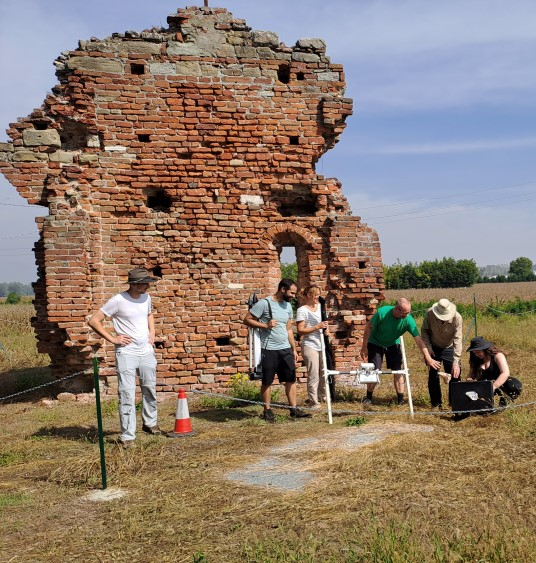
Abstract: The project Ancient and Modern Communities at Industria is a research effort of the Cotsen
Institute, Kent University (UK), Newcastle University (UK), and the Politecnico di Torino (Italy).
The main focus of the project is a diachronological study of communities and their environment. Starting with present day Monteu da Po, ancient Industria, in northern Italy, we aim to learn about tra
ditional farming, industry, and daily life of the inhabitants of the region through time, going back to the Roman Period (first century CE). Through a dialogue with the community, literature study, and archaeology, we aim to expand our understanding of ancient Industria, modern Monteu da Po, and neighboring communities. The project hopes to contribute to the economic development of the region. In our first field season we employed various non-destructive techniques near the ruins of the church of San Giovanni di Dustria, just north of the ancient city center.
Bios: Willeke Wendrich is a Professor of Egyptian Archaeology and Digital Humanities in the Department of Near Eastern Languages and Cultures, as well as the Joan Silsbee Chair of African Cultural Archaeology. She is the Director of the Cotsen Institute and Editor-in-Chief of the online UCLA Encyclopedia of Egyptology.
Hans Barnard MD, PhD is an Associate Adjunct Professor in the Department of Near Eastern Languages and Cultures as well as Associate Researcher at the Cotsen Institute of Archaeology. As an archaeological surveyor, photographer and ceramic analyst he has worked on sites in Armenia, Chile, Egypt, Iceland, Italy, Panama, Peru, Sudan, Syria, Tunisia and Yemen.
Contact Sumiji Takahashi
Email sutakahashi@ioa.ucla.edu
Phone 310-825-4169
The conference is co-organized by Stella Nair (University of California, Los Angeles) and Paul Niell (Florida State University), who are joined by Dr. Shannon Speed (University of California, Los Angeles) for the organization of the workshops. This project is made possible through support from the Terra Foundation for American Art, and is co-sponsored by the UCLA American Indian Studies Center and UCLA Latin American Institute.
To register for in-person conference attendance at the Clark Library (Friday and Saturday morning), please, email c1718cs@humnet.ucla.edu Additionally, the conference talks will be livestreamed on the UCLA Center for 17th- & 18th-Century Studies YouTube channel.
Register here to attend the workshop that will take place in person only in the afternoon of Saturday, April 15 at the Chumash Museum in Los Angeles.
For more information, see flyers below and check the event's own website and that of the Center for 17th- & 18th-Century Studies.
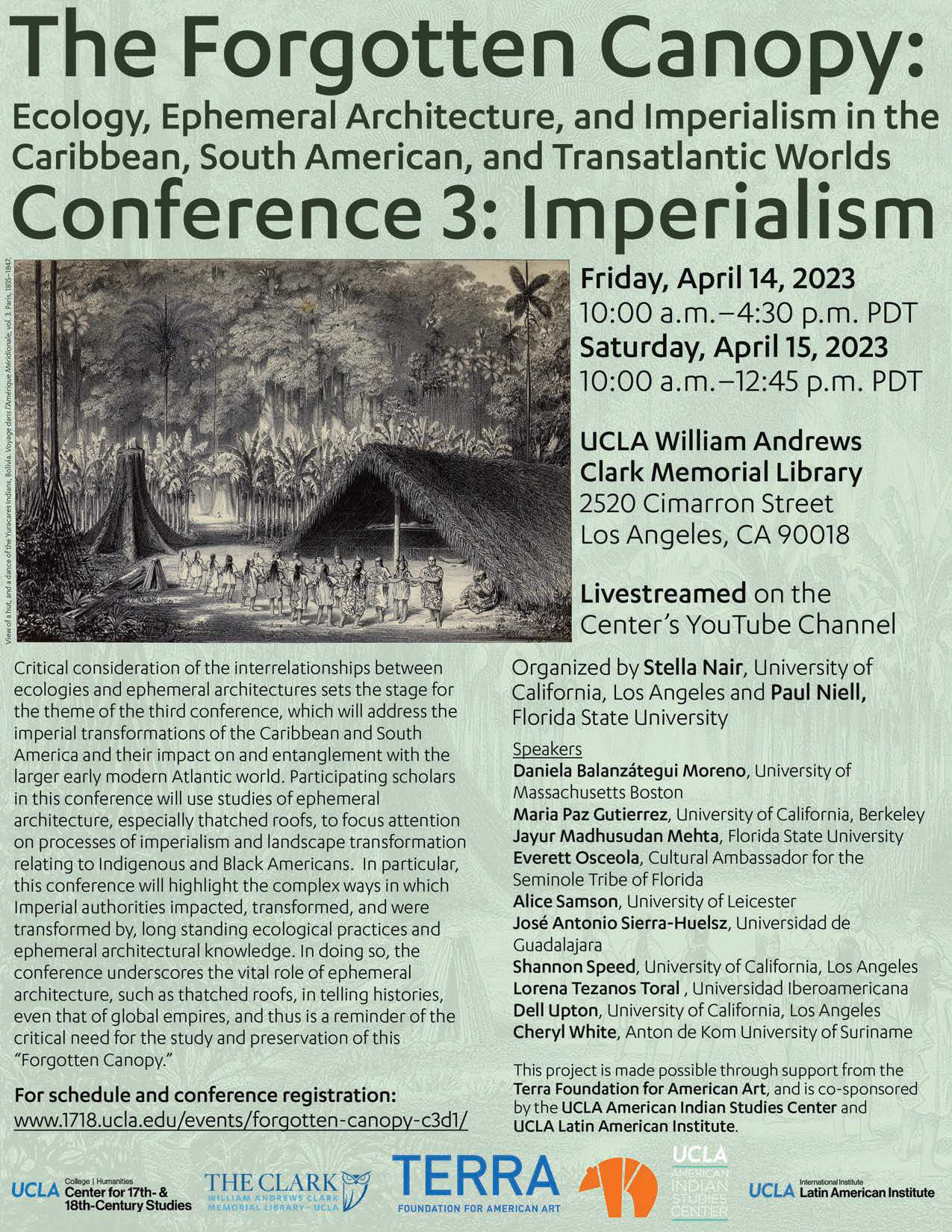
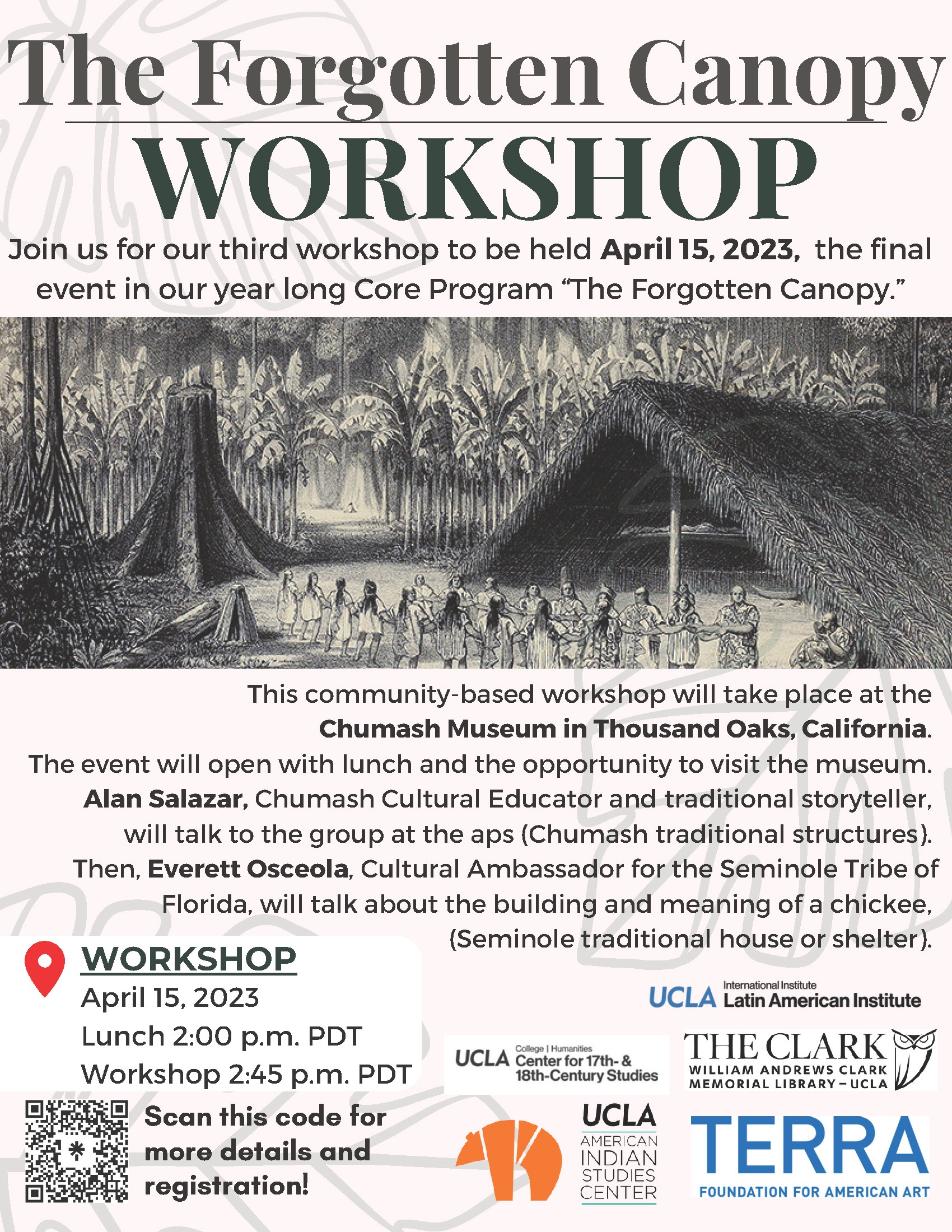
Contact Stella Nair
Email theforgottencanopy1496@gmail.com
Phone
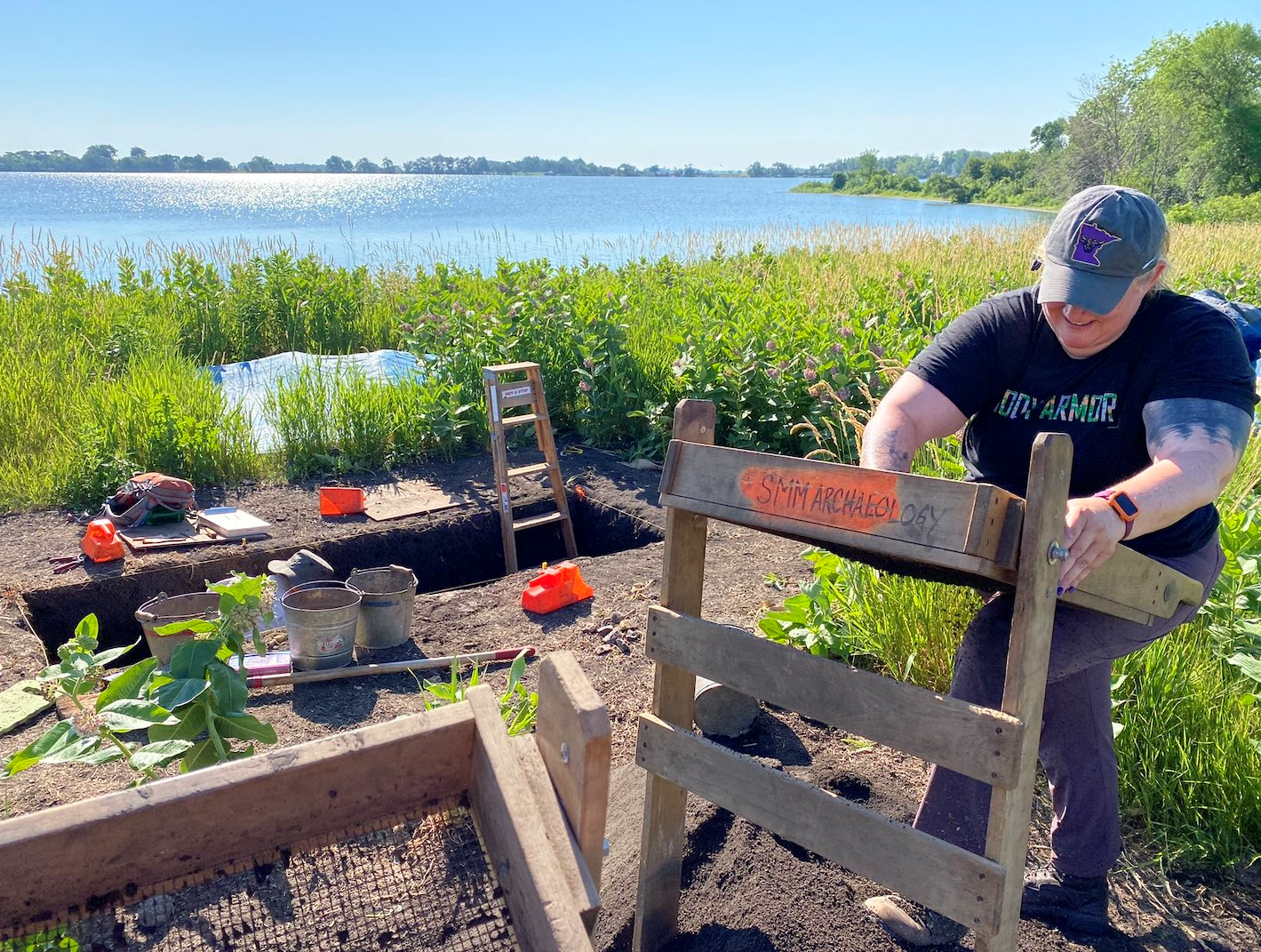
Abstract: People have occupied and visited the Pedersen Site (21LN2), an island site in southwestern Minnesota, for at least 12,000 years. The site is rare in Minnesota, containing some of the earliest stone tools and evidence of repeated occupation up to the present day. The Science Museum of Minnesota began investigating the site from 1973-1975, amassing a large collection that remained largely uninventoried for many decades, making it difficult to access or research. In this talk, I will discuss the rehousing of the collection to adhere to modern standards as well as preliminary findings and some pretty cool artifacts in the assemblage. The second part of the talk will be about the 2021-2022 excavation/survey of the island to explore previously uninvestigated areas, detailing why we were there and the amazing finds we uncovered during the dig.
Bio: Taylor Brehm is a first-year conservation master's graduate student in the UCLA/Getty Conservation Program. She received her BA in archaeology with a minor in anthropology from the University of Wisconsin-La Crosse. Before arriving at UCLA, she worked in the conservation and archaeology departments at the Science Museum of Minnesota as well as a private practice conservation firm in Minneapolis, Minnesota.
Contact Sumiji Takahashi
Email sutakahashi@ioa.ucla.edu
Phone 310-825-4169
Parker VanValkenburgh
Associate Professor in the Anthropology Department at Brown University
Friday, March 3rd 12pm PT
Register at https://tinyurl.com/AWGKuelap
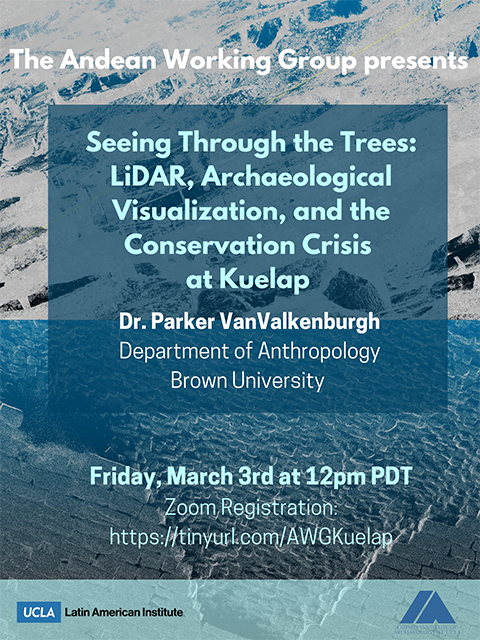
Organized by the Andean Working Group and cosponsored by the Cotsen Institute of Archaeology and the UCLA Latin American Institute
Contact Rachel Schloss
Email rachelschloss@g.ucla.edu
Phone
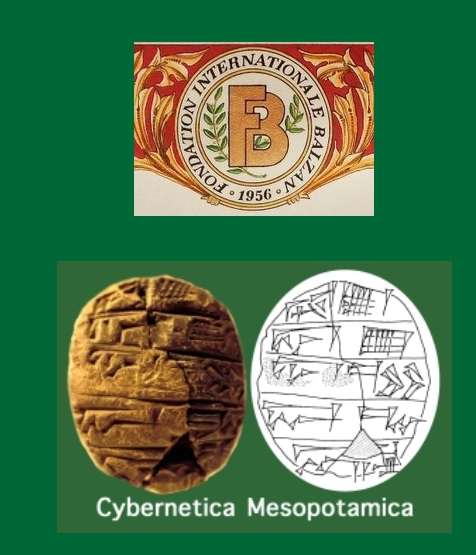 ABSTRACT: Archaeological publishing rests on two basic pillars: printed reports and digital databases. We propose to use the website as an epistemic system that allows for a better integration of the two. We will first present a concrete implementation of the system as it applies to the excavations at Tell Mozan, ancient Urkesh. The digital record consists of a cluster of websites where narrative and databases are tightly interlaced, allowing for a smooth interconnection between grammar and hermeneutics: the dignity of the fragment rests on the dual aspect of its retaining its individuality while at the same time being seen as part of a meaningful whole. We will then discuss the notion of digital discourse as a theoretical model, according to which multiple planes are structurally interlaced and integrated, having been so conceived, concurrently, by the author(s) so as to be so.
ABSTRACT: Archaeological publishing rests on two basic pillars: printed reports and digital databases. We propose to use the website as an epistemic system that allows for a better integration of the two. We will first present a concrete implementation of the system as it applies to the excavations at Tell Mozan, ancient Urkesh. The digital record consists of a cluster of websites where narrative and databases are tightly interlaced, allowing for a smooth interconnection between grammar and hermeneutics: the dignity of the fragment rests on the dual aspect of its retaining its individuality while at the same time being seen as part of a meaningful whole. We will then discuss the notion of digital discourse as a theoretical model, according to which multiple planes are structurally interlaced and integrated, having been so conceived, concurrently, by the author(s) so as to be so.
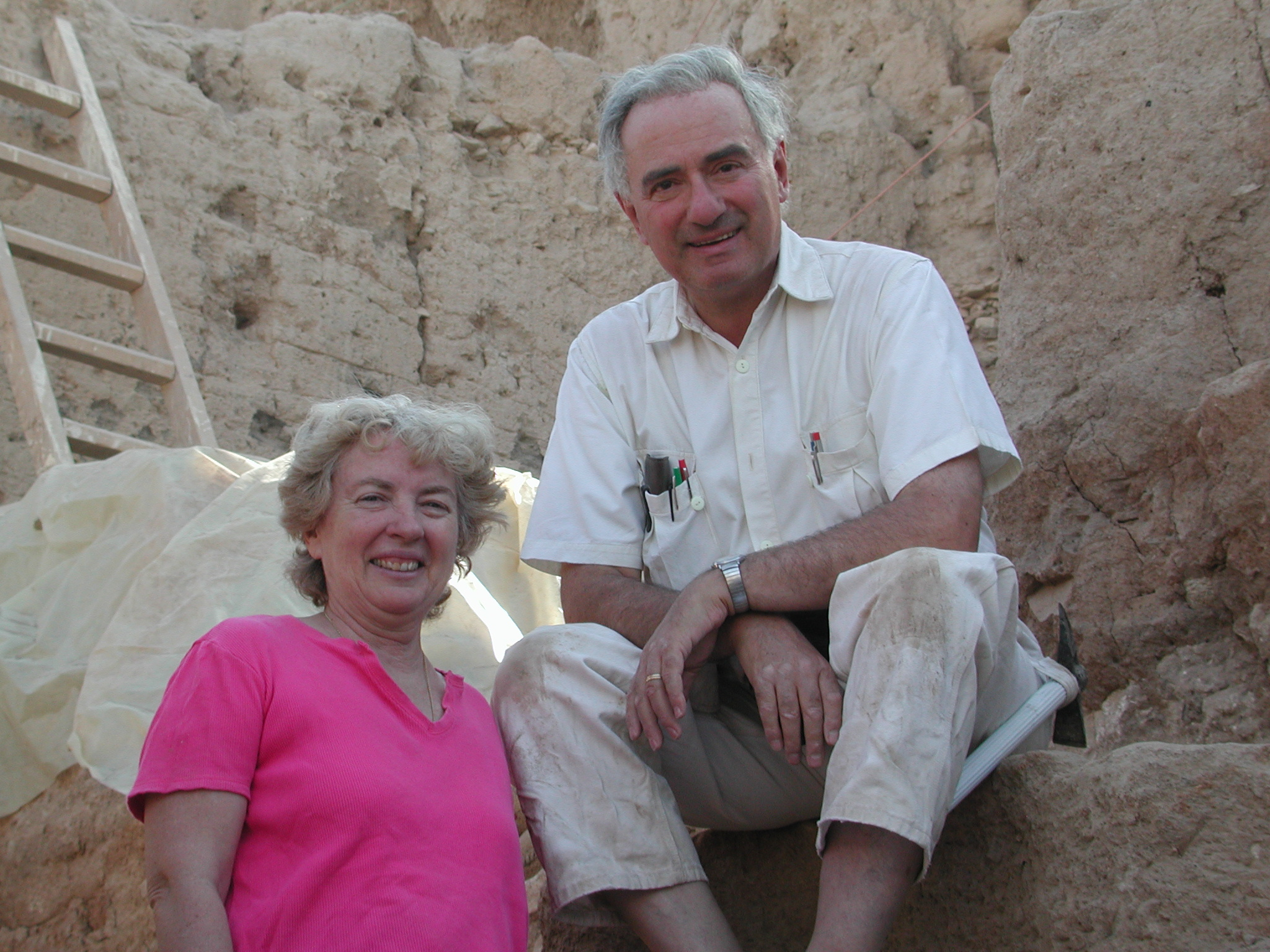
Contact Sumiji Takahashi
Email sutakahashi@ioa.ucla.edu
Phone 310-825-4169
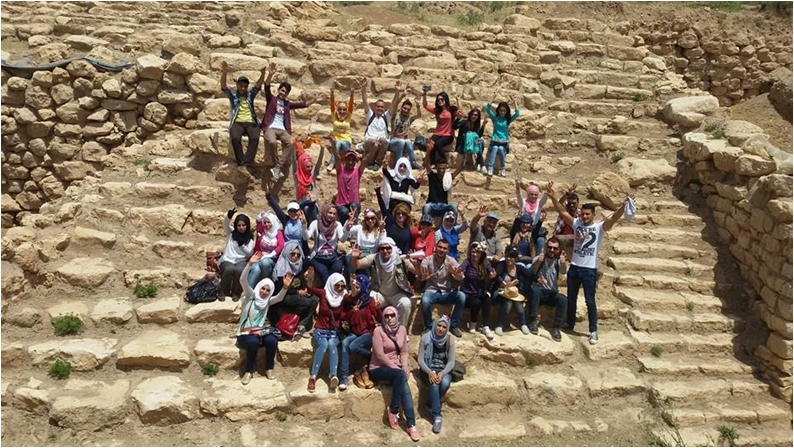 A conversation with
A conversation with
Giorgio Buccellati
Marilyn Kelly-Buccellati
Maryanne Wolf
February 16, 2023
6:00 PM PT
Remote via Zoom
Join us in unearthing the secrets of a 5,000-year-old civilization when cities first began to take shape. In northeastern Syria, the Hurrian city of Urkesh had been excavated and studied for twenty-five years before the work was halted by war. Learn how the study of Urkesh has been impacted by plundering and defacing but continues to engage the local community and provide impactful records even beyond archaeology. Archaeologists Giorgio Buccellati and Marilyn Kelly-Buccellati will be joined by neuropsychologist Maryanne Wolf for a conversation where cognitive psychology meets archaeology.
Registration Required
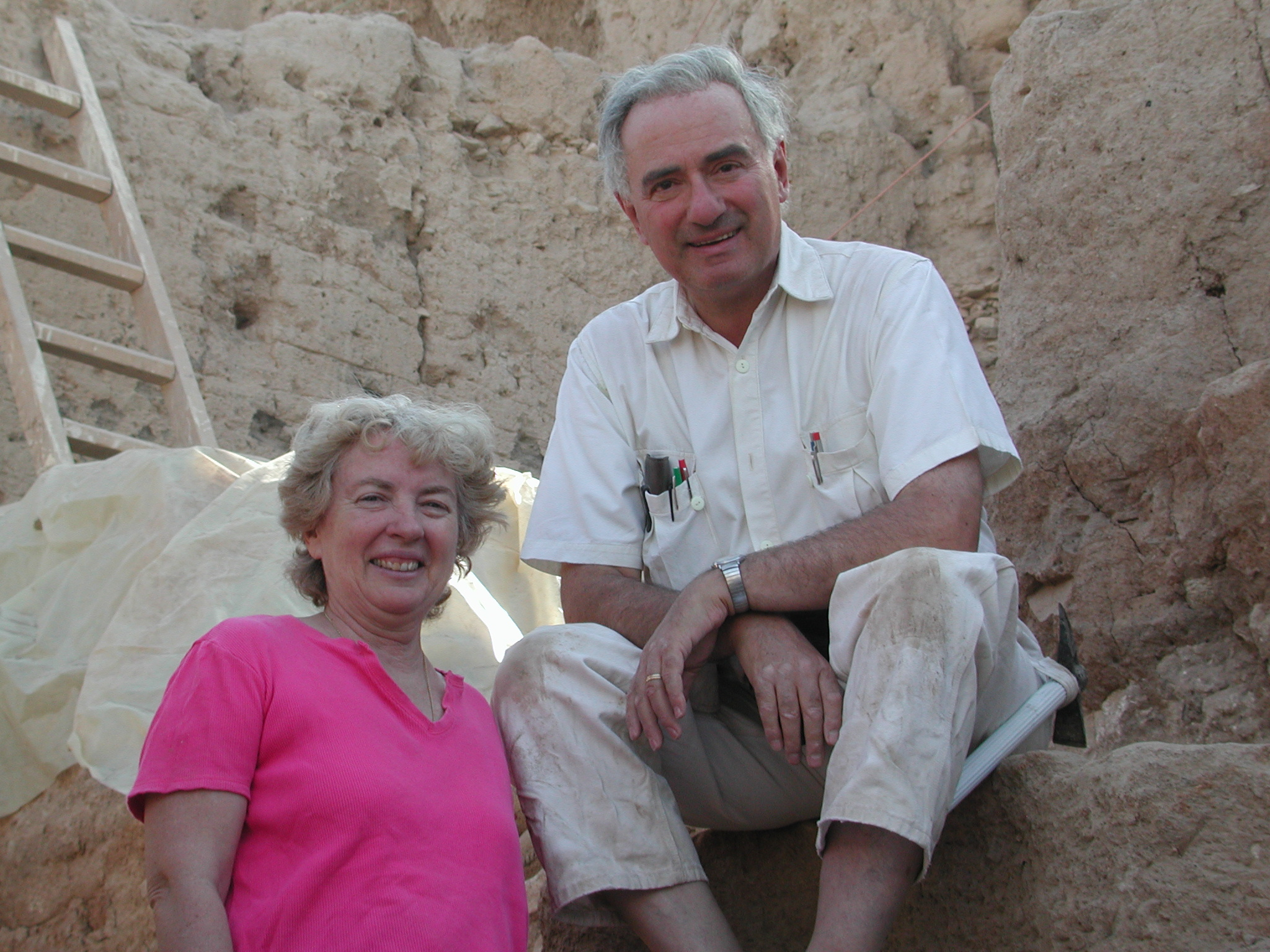
Contact Michelle Jacobson
Email mjacobson@ioa.ucla.edu
Phone
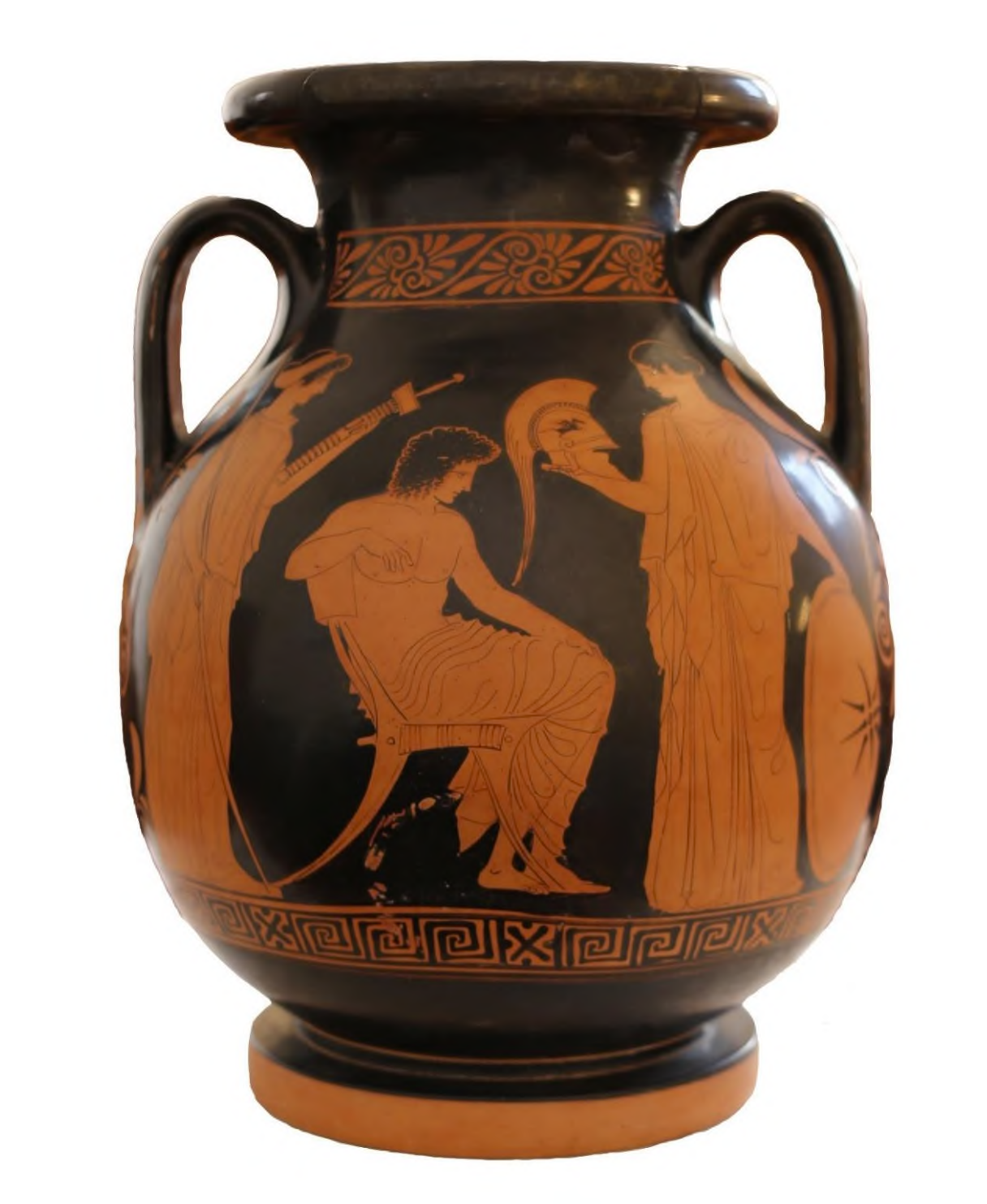
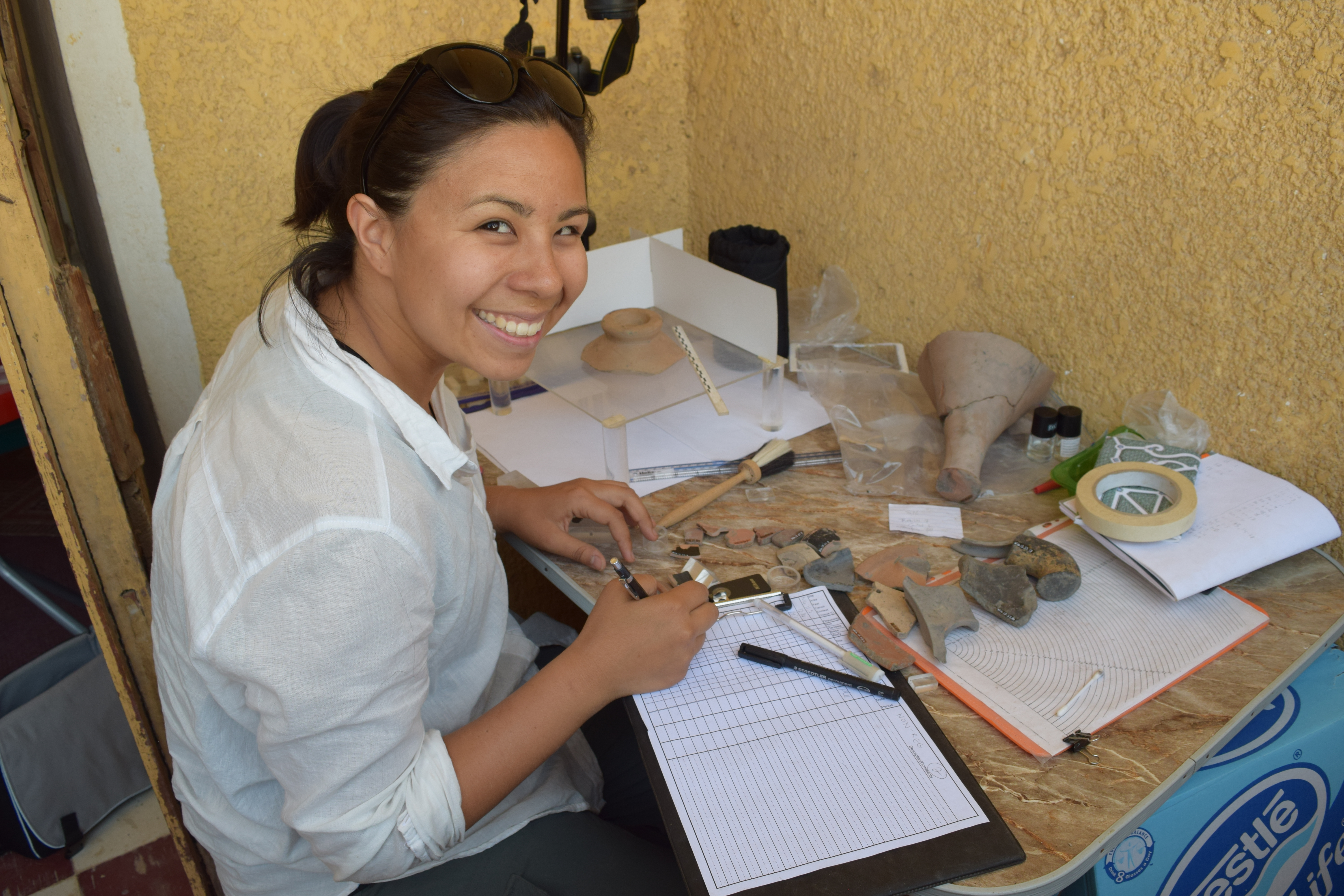
Contact
Email sutakahashi@ioa.ucla.edu
Phone 310-825-4169
Abstract: Migrants are thought to have facilitated the exchange of goods and ideas around the Mediterranean throughout Greek history, yet the lived experiences of these individuals, families, and communities remain relatively under-studied. The cultural identities of migrants are often fixed to their place of origin, perceived by scholars as “others” in the new societies in which they lived. Archaeological approaches to the burials of migrants assume that this “otherness” will be reflected in material culture, with imported grave goods and practices used as the basis for the identification of the grave of a migrant. This talk will challenge these assumptions through the analysis of the burial of a man from Chios in late 5th century BC Athens, not only by comparing the burial practices of Chios and Athens to identify which practices were maintained, abandoned, or altered, but also by contextualizing the burial through the deceased’s age, gender, status, occupation, and possible reasons for leaving home.
Bio: Camille Reiko Acosta is a PhD candidate at the Cotsen Institute of Archaeology at UCLA. She received her BA from the University of Edinburgh and her MA from the University of Oxford. Her dissertation project focuses on the burial practices of migrants in Classical Athens, and additionally, she is a member of the British Museum’s Naukratis Project (Egypt) and UCLA’s Ancient Methone Archaeological Project (Greece), studying the Archaic and Classical Greek ceramic assemblages.
RSVP for remote attendance here: https://ucla.zoom.us/meeting/register/tJYuc-mhpzMqGdcF0LNaSAOHbvlE9PvtJ6Ny
Contact Sumiji Takahashi
Email sutakahashi@ioa.ucla.edu
Phone 310-825-4169
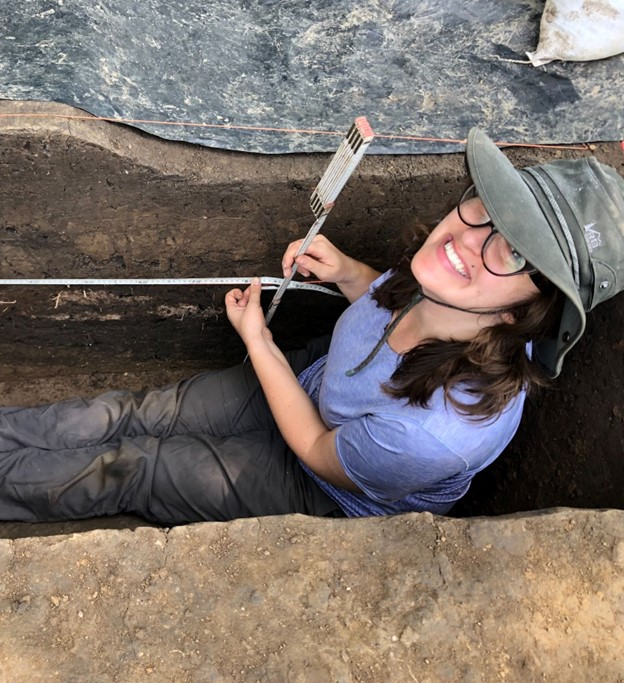 Abstract: Tres Zapotes is an important site in the broader discussion of Olmec cultural continuity and formative period political economy with an archaeological record that spans the two millennia between 1000 B.C. and A.D. 1000. It is a key site for understanding the emergence of Classic period civilization from ancient Olmec roots in Mexico’s southern Gulf Coast lowlands. The occupational history and archaeological record at Tres Zapotes challenges the previous notion that Olmec culture and traditions “collapsed” with the decline of La Venta around 400 B.C. and recent work has argued that a shift from a centralized political structure to a more decentralized/collective one can be attributed to the fluorescence of Tres Zapotes when other polities fell. To expand upon this work, I utilize paleoethnobotanical data from Tres Zapotes to examine what patterns in foodways (practices surrounding food production, consumption, storage and disposal) can reveal regarding sociopolitical transformations over Tres Zapotes’ long culture sequence. Comparative analyses across elite and non-elite contexts through time reveals changes in provisioning and processing strategies providing insight into the role of food, especially maize, throughout Tres Zapotes’ continuous occupation and the changes in political-strategies therein.
Abstract: Tres Zapotes is an important site in the broader discussion of Olmec cultural continuity and formative period political economy with an archaeological record that spans the two millennia between 1000 B.C. and A.D. 1000. It is a key site for understanding the emergence of Classic period civilization from ancient Olmec roots in Mexico’s southern Gulf Coast lowlands. The occupational history and archaeological record at Tres Zapotes challenges the previous notion that Olmec culture and traditions “collapsed” with the decline of La Venta around 400 B.C. and recent work has argued that a shift from a centralized political structure to a more decentralized/collective one can be attributed to the fluorescence of Tres Zapotes when other polities fell. To expand upon this work, I utilize paleoethnobotanical data from Tres Zapotes to examine what patterns in foodways (practices surrounding food production, consumption, storage and disposal) can reveal regarding sociopolitical transformations over Tres Zapotes’ long culture sequence. Comparative analyses across elite and non-elite contexts through time reveals changes in provisioning and processing strategies providing insight into the role of food, especially maize, throughout Tres Zapotes’ continuous occupation and the changes in political-strategies therein.
Bio: Victoria Newhall is a third year archaeology graduate student in the Department of Anthropology at UCLA. Her research explores emergent social inequality and the development of socio-political complexity in Formative Mesoamerica through the lens of foodways utilizing paleoethnobotanical methods. She is also interested in social identity and issues of equity and diversity as they relate to the discipline of archeology. Victoria is a non-traditional student who transferred from Santa Barbara City College to UCSB for her undergraduate degree. She is dedicated to mentoring students who are navigating similar pathways in higher education.
Contact
Email sutakahashi@ioa.ucla.edu
Phone 310-825-4169
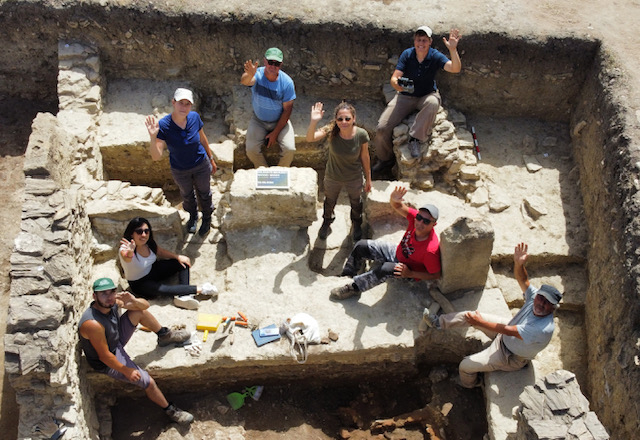
Abstract: The city of Selinous, on the southern coast of Sicily, was founded by Greek settlers at the end of the 7th century BCE. After being destroyed by the Carthaginians at the end of the fifth century BCE it was used as a fortress and subsequently rebuilt as a civil settlement with distinct material characteristics known from the Punic sphere of influence. During the first Punic war it was abandoned and never extensively reoccupied. For this reason, the city of the Greek period is still largely preserved and well protected in one of the biggest archaeological parks of Europe. Its monumental sacred and public spaces are widely known, yet, many questions remain concerning not only the various transformations of the area after the catastrophic event of 409 BCE, but also the specific development and use of the urban space from the 7th century onwards.
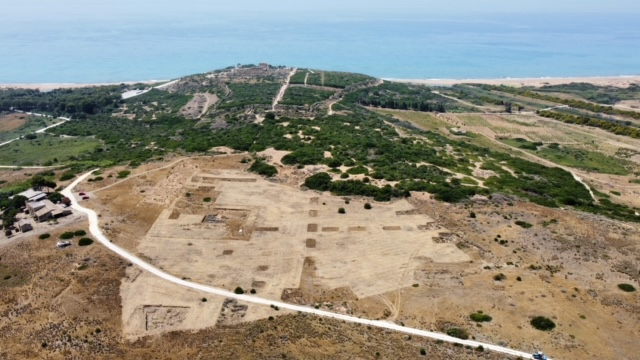
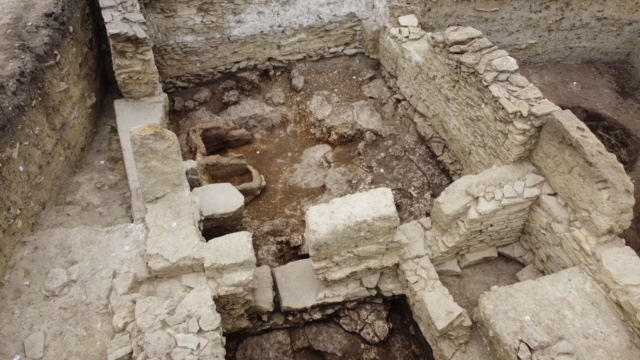
Bio: Dr. Melanie Jonasch is a Classical archaeologist and research associate at the German Archaeological Institute in Rome and Berlin. Since 2021 she has coordinated a multidisciplinary field- project in Selinous (Sicily) and is responsible for the archaeological excavations conducted in this framework. She will be a fellow of the AIA at the Cotsen-Institute of Archaeology until April where she will begin work on a new project about population aggregation and the development of secondary settlements in the neighborhood of the emerging Greek colonies.
Contact Sumiji Takahashi
Email sutakahashi@ioa.ucla.edu
Phone 310-825-4169
- ‹ previous
- 10 of 50
- next ›
